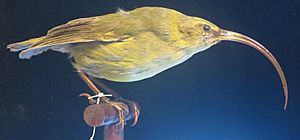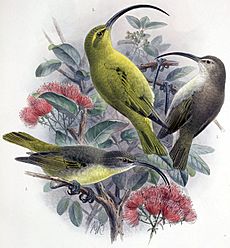Kauaʻi ʻakialoa facts for kids
Quick facts for kids Kauai ʻakialoa |
|
|---|---|
 |
|
| Specimen in Bishop Museum, Honolulu | |
| Conservation status | |
| Scientific classification | |
| Genus: |
Akialoa
|
| Species: |
stejnegeri
|
| Synonyms | |
|
Hemignathus ellisianus stejnegeri Hemignathus stejnegeri |
|
The Kauai ʻakialoa (Akialoa stejnegeri) was a special type of Hawaiian honeycreeper. These birds are part of the finch family. The Kauai ʻakialoa lived only on the island of Kauai, Hawaii. This means it was endemic to Kauai. Sadly, it became extinct in the 20th century. This happened because of diseases brought by new birds and the loss of its home, called habitat loss.
The Kauai ʻakialoa was about 7.5 inches (19 cm) long. It had a very long, curved beak that was about one-third of its total length. Adult males were bright olive-yellow on top and yellow underneath. Their throat, chest, and sides were also olive-yellow. Females were different; they were gray-green on top and had a shorter beak.
Contents
Where the Kauai ʻAkialoa Lived and What It Did
Scientists believe the Kauai ʻakialoa lived in forests high up, above 1,148 feet (350 meters) above sea level. However, people often saw it flying to lower parts of the island. This rare and unique bird used its long, curved beak to reach nectar from special flowers. These included lobelia and ʻohiʻa blossoms.
It also ate insects. It would find them hidden under tree bark or under moss and lichen on trees. In 1896, a type of parasite called Apororhynchus hemignathi was found in the gut of a Kauai ʻakialoa.
The History of the Kauai ʻAkialoa
The Kauai ʻakialoa was rare even when it was first discovered in the 1700s. Other types of ʻakialoa birds lived on different Hawaiian islands, but they are all now considered separate species. Records from old bones (fossils) show that their numbers dropped a lot in the early 1900s. The Kauai ʻakialoa usually lived in warm, wet lowland forests or moist mountain forests in Hawaii.
Many people think that the bird's trips to lower parts of the island caused its downfall. This is because of a bird disease found at lower elevations. A new type of mosquito, which carried this disease, first arrived on whaling ships in 1826. These mosquitoes liked warm, wet places at low elevations. These were the same conditions where ʻakialoa birds were found.
These mosquitoes carried a type of malaria that infected and killed many ʻakialoa birds. This started the slow disappearance of the species. It also affected many other Hawaiian bird species.
The last time a Kauai ʻakialoa was officially seen was in 1967. ʻAkialoa birds used to live on all the larger Hawaiian islands. But the Kauai species seemed to survive longer than the others. Sadly, scientists now believe that even this bird has become extinct. Because these birds were so rare, we don't know much about their daily lives.
Changes to the low-elevation forests caused many forest birds on Kauai to disappear. These changes began when the first Polynesians settled on the island. They cut down trees and cleared land for farming. With new settlers, new plants and animals that were not native to Hawaii arrived. These are called invasive species. Today, only about 40,000 acres (160 square kilometers) of Kauai's land have not been greatly changed. Many bird diseases and parasites also threaten Hawaii's forest birds. Big forest fires on the islands in the past also destroyed more of the Kauai ʻakialoa's home.
Protecting the Forests and Birds
The Forest Reserve Act of 1903 was created to protect the forests and river areas on Kauai. In 1907, the Hawaiian Territorial Legislature passed a law to protect all native perching birds. In 1964, two scientists, F. Richardson and J. Bowles, wrote a report about the birds of Kauai. They showed the world how fragile these beautiful birds were.
The Kauai ʻakialoa was listed as an endangered species in 1967. This was under the federal Endangered Species Act. From 1968 to 1973, bird surveys were done on Kauai. A lot of work has been done to study the puaiohi, another rare Kauai forest bird. However, no Kauai ʻakialoa birds have been seen during these studies.
See also
 In Spanish: Akialoa de Kauai para niños
In Spanish: Akialoa de Kauai para niños



